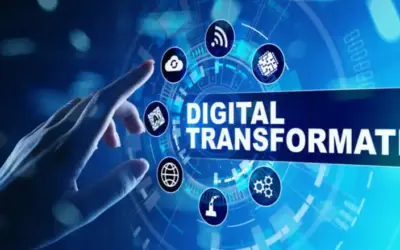When most people think about sustainable product creation, they may think about things like recyclability. But there’s so much more to it than that. Sustainable product creation is the process of designing and bringing products to market in a way that considers the environmental, social, and economic impacts of those products throughout their entire lifecycle. It also includes minimizing negative impacts on the environment, such as greenhouse gas emissions and water usage. Products can be made of recycled materials, use renewable resources, or be biodegradable. It’s important to think about all the aspects of a product when trying to make it more sustainable, from the way it’s designed and manufactured to the way it’s used and repurposed at the end of its life.
What is digital transformation?
Digital transformation is the process of integrating digital technology into all aspects of a business in order to better connect with customers, improve efficiency, and create new opportunities. It is a critical strategy for companies that want to stay competitive in the digital age. There are many factors that contribute to a successful digital transformation. One of the most important is the leadership’s commitment to change. The entire organization must be on board from the top down in order to be successful. Employees must also be given the tools they need to work in a digital environment.
- Improved efficiency: Cloud technology can help your business improve its efficiency by allowing you to access data and applications from anywhere
- Scalability: Cloud technology can help your business scale its operations quickly and easily without the need to invest in additional hardware or software
- Flexibility: Cloud technology can help your business become more agile by allowing you to quickly and easily adapt to changes in demand.
Reducing the Sustainability Impact of Digitalization
While digital technologies drive significant advancements in sustainability, the digital sector itself poses notable sustainability challenges. Data centers are a significant source of greenhouse gas (GHG) emissions, consuming 1.5% of global electricity annually—a figure projected to reach 8% by 2030.
As underlined by Arthur D. Little, reducing the sustainability impact of digitalization requires targeted efforts across multiple dimensions of IT and digital operations. Below are key levers that companies can adopt:
- Compute Efficiency: Optimizing how infrastructure is run can reduce the energy intensity of operations. This includes consolidating server utilization, thus ensuring servers are shared within and between companies to eliminate idle capacity.
- Cloud Migration: Shifting IT services to the cloud can reduce emissions, especially when leveraging cloud providers committed to sustainability. Selecting providers with data centers located in regions with natural cooling or access to renewable energy is a long-term strategy for sustainability gains.
- Sustainable Software Engineering: Streamlining software to reduce server demands minimizes environmental impact. For example, adopting efficient programming languages and avoiding unused functionalities can prevent unnecessary energy consumption.
- Sustainable Vendor Management: Many IT functions are outsourced. Companies must assess vendor sustainability practices, enforce standards, and account for their supply chain emissions.
- Circular IT Practices: Extending the lifecycle of IT hardware through reuse, repair, and refurbishment reduces waste and unlocks the embedded value of materials. However, progress in circularity often requires regulatory support.
What is a digital twin?
Digital twin is “a digital representation of an asset, system, product, or creature realized through a system with an objective to simplify management of its lifecycle and operation. Digital twins can be connected and added to each other to manage highly complex scenarios. The digital twin representation can be augmented with additional technologies such as simulation, optimization, and machine learning to realize additional benefits.”
Cloud-Powered Technologies to Boost Decarbonization Initiatives
Cloud-powered technologies are proving to be the most critical enablers in accelerating decarbonization efforts. McKinsey highlights that the cloud can expedite 47% of all decarbonization initiatives, reducing costs by 2–10% per initiative.
Cloud technologies have the potential to reduce up to 32 gigatons of CO₂ emissions annually, with a direct impact of 1.5 gigatons projected by 2050. Manufacturing and transportation are among the sectors with the highest potential gains. By supporting advanced tools like digital twins and data exchanges, cloud-powered technologies can optimize resources, reduce emissions, and ensure compliance with evolving sustainability regulations.
These tools also enhance the speed and effectiveness of sustainability transformations, delivering financial and environmental returns. Let’s explore the most relevant ones: AI, IoT, and machine learning (ML).
Source: McKinsey
How lifecycle analysis improves product sustainability
From sourcing raw materials to delivering completed items, LCA provides a cohesive overview of the effect your company’s products and services have on the environment. It asks questions about product design and material choice optimization, manufacturing processes, and distribution methods. LCA addresses concerns like these based on reliable data collated from thousands of sources within your business. Traditional LCA assesses the impact of previous actions and is distinct from day-to-day company operations. LCA, on the other hand, can accomplish so much more with enhanced digitization.
To Conclude
This is the decade to deliver on the sustainable development goals. The most effective way of accelerating strategy for sustainability is by committing to a comprehensive, organization-wide digital transformation.
Ready to align your digital strategy with sustainability goals? Schedule a free consultation with The Expert Community today to unlock tech-driven growth
FAQ
1. What is an enterprise digital strategy, and why is it important for sustainable growth?
An enterprise digital strategy is a roadmap that guides how a business leverages digital technologies to improve operations, enhance customer experiences, and drive innovation. It’s crucial for sustainable growth as it helps reduce inefficiencies, scale responsibly, and adapt to evolving market demands.
2. How can digital transformation support environmental sustainability?
Digital tools like IoT, AI, and cloud computing can optimize energy use, reduce waste, and enable remote operations—leading to a smaller carbon footprint and more sustainable resource management.
3. What technologies are key to building a sustainable digital enterprise?
Key technologies include AI for predictive analytics, cloud computing for scalability, blockchain for transparency, and automation for process efficiency—all contributing to long-term sustainable performance.
4. How should a company begin its digital strategy journey for sustainability?
Start by assessing current digital maturity, identifying sustainability goals, and aligning tech investments with business priorities. Involving stakeholders across departments ensures better integration and measurable outcomes.
5. What are the risks of not adopting a digital strategy focused on sustainability?
Companies risk falling behind competitors, missing regulatory targets, increasing operational costs, and losing stakeholder trust if they fail to integrate sustainability into their digital strategy.







